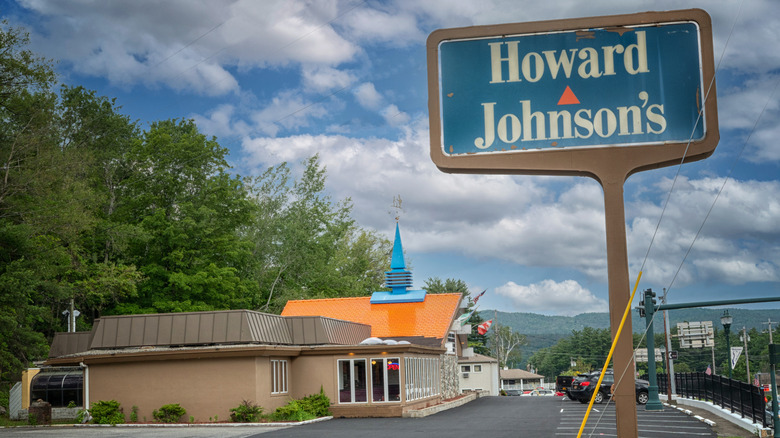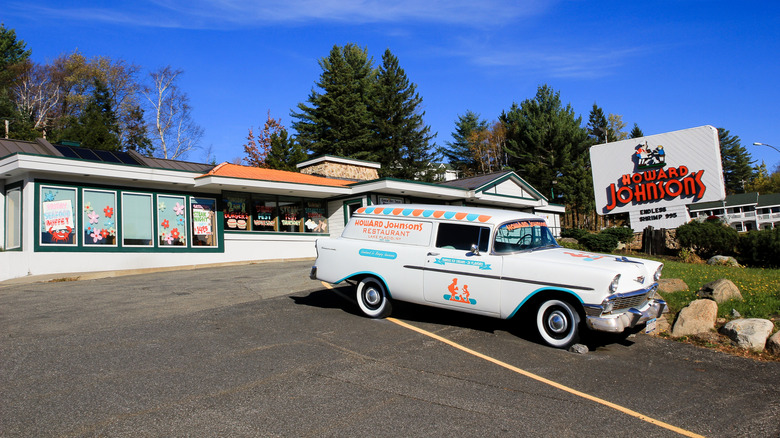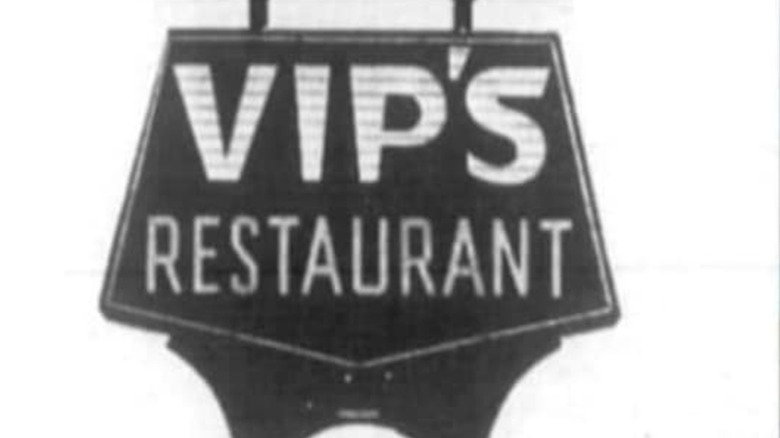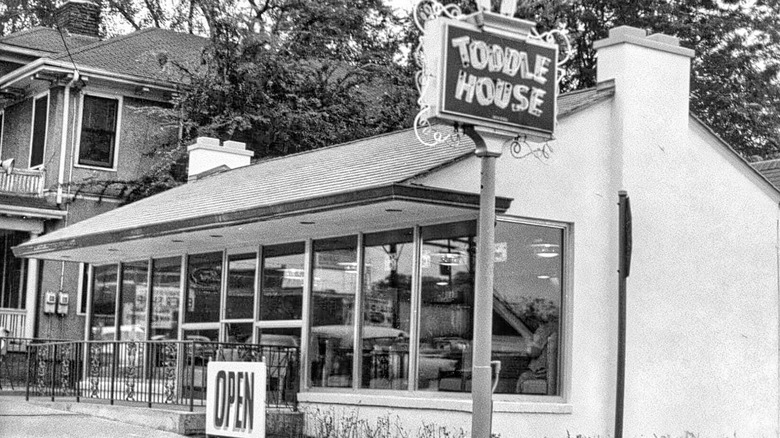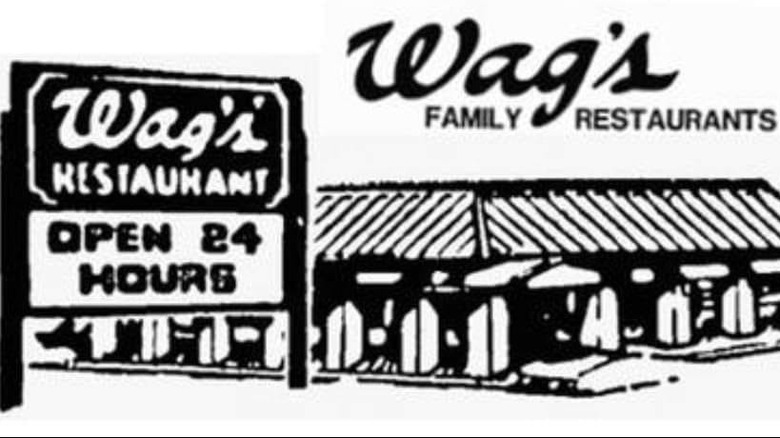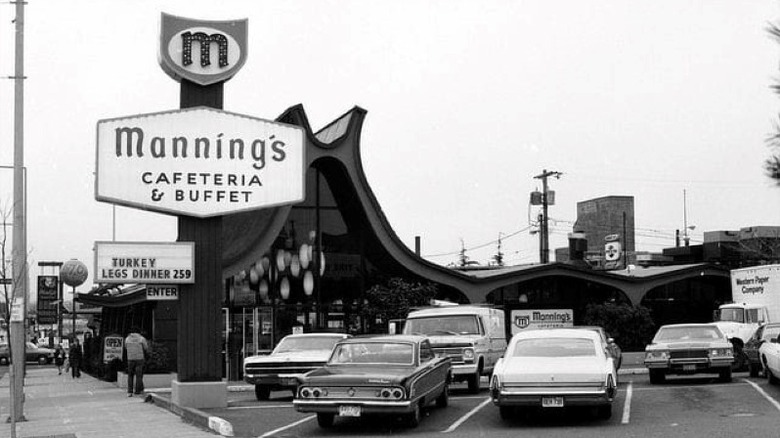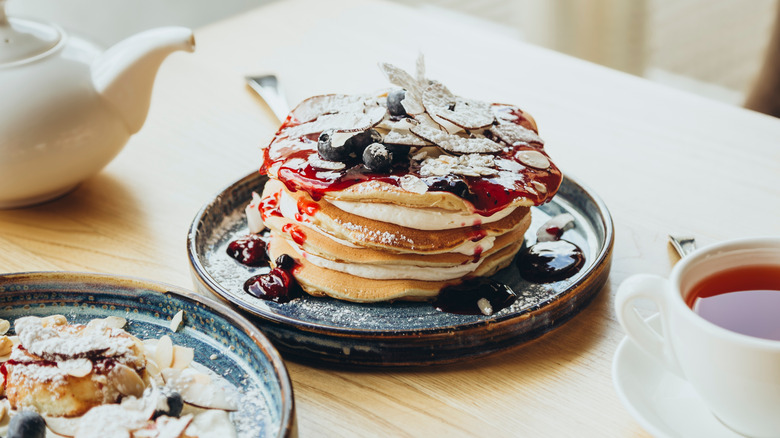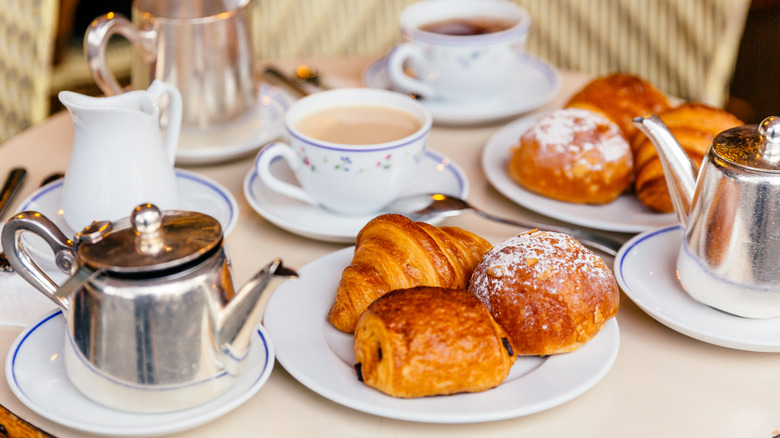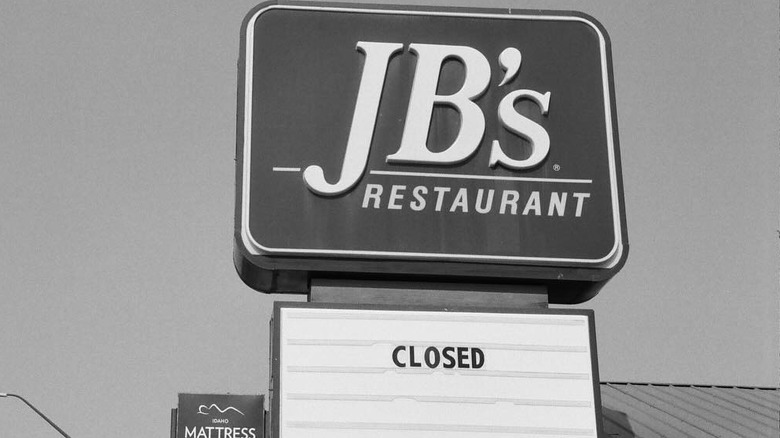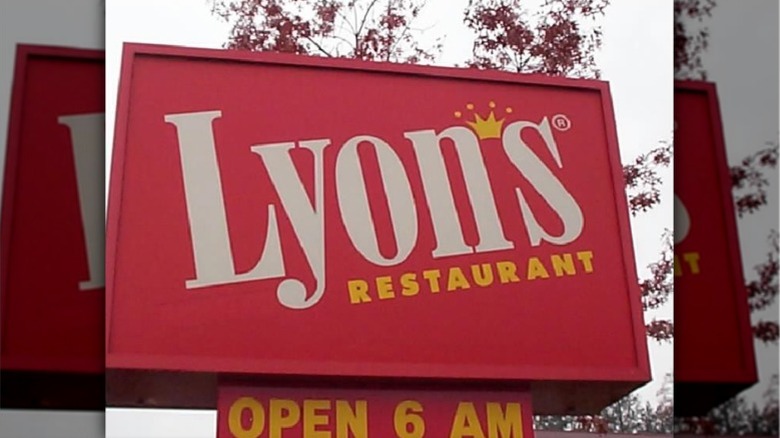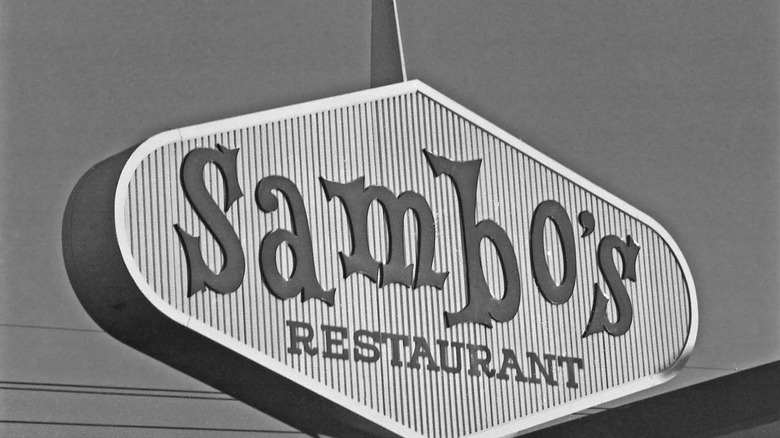Once Popular Breakfast Chains That Completely Disappeared
For popular breakfast chains – Denny's prepares to shut down almost 100 restaurants this year – it certainly is an interesting time. Several of these breakfast chains are slowly disappearing across the United States. It's hard not to feel nostalgic for the once-loved chains that have now vanished completely. These weren't just places where you would go and grab eggs, bacon, and pancakes, they were the heartbeat of each community they were located in. Families would go there for their after-church traditions, birthday celebrations, and random family meals. These were also cool hangout spots for kids after school as well as great places for first dates.
There's something uniquely comforting about a cool breakfast spot, and for many, these restaurants provided a sense of familiarity no matter the city. These breakfast chains had to shut down due to a number of reasons. While some could not keep up with the increasing competition, and others experienced operational costs they couldn't keep up with, some of these breakfast chains shut down simply because of poor management. And, while Denny's still holds on — at least for now — others haven't been as lucky. A lot of memories were made at these breakfast chains, and we're here to take you on a trip down memory lane.
Howard Johnson's
We know many have been wondering whatever happened to Howard Johnson's restaurants – you're not alone. This used to be America's largest restaurant chain with almost 1,000 restaurants all over the country in the '60s and '70s. All restaurants served 28 types of ice cream, and in those days, that was just a dream come true. You could spot a Howard Johnson's restaurant from miles away because they had bright orange roofs. Most people would start mentally planning their meals while still a mile away from the restaurant, already imagining their order by the time they pulled into the parking lot. The bright orange roofs, visible from a distance, sparked excitement — especially for children riding downhill with their parents. The anticipation of arriving made the whole experience feel like a treat for everyone.
Unfortunately, mismanagement and rising competition from restaurants that had their ducks in a row, like McDonald's, caused the restaurant chain to start selling some of its restaurants as it was slowly becoming bankrupt. The production of the hit series, "Mad Men," did help the restaurant regain popularity for a short period since some of the scenes were shot inside Howard Johnson's. However, this was not enough to get the chain to make a comeback and it continued to shut down and sell locations over the years. The last location at Lake George shut down in 2022, officially putting an end to the story of Howard Johnson's breakfast chain.
VIP's
VIP's was founded by Keith Andler and Robert Smith in Oregon, 1968. It was originally founded as a simple pancake house chain that eventually grew and expanded its menu. The breakfast chain really did want to make its customers feel extra special as it was called "The very important people's restaurant” and shortened to VIP's for ease of use. The name itself would have had us walking into the restaurant with a delighted bounce to our steps. Although it did not have locations all over the United States, it had 53 restaurants that were located in Oregon, California, Washington, Idaho and Nevada – which was quite impressive. It was also the largest restaurant chain in Oregon at that time. A lot of these restaurants were located near highway exits since the founders had experienced major success with the very first restaurant that was also near an exit, and not much luck when they tried to open a second one that was far from a highway exit. The restaurants were strategically positioned and convenient for both travelers and locals.
In 1982, the chain sold 35 of its restaurants to Denny's for 12 million dollars. However, this turned out to be a wrong move as the sale affected its overall brand and it began to experience major losses while Denny's slowly gained popularity. This led to more selling of restaurants as time went by until the chain eventually became defunct in 1989. VIP's seemed to have a lot of things going right – steady traffic of customers, good food, great decor, and great service so it definitely should've been a chain that's still in existence today.
Toddle House
This legendary breakfast chain was founded in the mid 1920s by a man named Fred Smith who sold his bus company (the Dixie Greyhound Lines) to open the Toddle House restaurant chain. All buildings in the chain were exactly the same — tiny brick cottages that were painted white with blue roofs. There weren't any tables for diners inside the Toddle House buildings. Instead, there were just 10 stools that were close to a stainless steel counter. Although space inside the restaurant was very tight and limited, it shined through its menu. One thing that made it a beloved restaurant was the fact that it was open 24 hours a day, ready to serve whenever. This was especially handy for mothers that needed a last minute meal for their families or night owls that would just need to grab a quick bite.
The Toddle House hash browns were prepared on the grill right in front of you which was something the customers found to be quite thrilling and exciting. Other fan favorites from the restaurant were the banana cream pie, chocolate icebox pie, grilled cheese sandwiches, and, of course, all-day breakfast. While the chain might be defunct now, its menu lives on in the Waffle House menu, making it bittersweet for those that still remember Toddle House for its heydays. By the '50s, the chain had 200 locations in cities across the country, but was sold — despite its success — to Dobbs House which already had its own chain of diners. The sale resulted in all the Toddle Houses being either shut down, converted to steak and egg kitchens, or renamed and rebranded to Dobbs House.
Wag's
This breakfast chain was founded by Walgreens in the '70s. The structure of the restaurant was largely inspired by Denny's and Big Boy restaurants which were doing really well and would operate 24 hours a day, serving delicious breakfast to its customers. Its menu included traditional club sandwiches, French toast, patty melts, and had really affordable prices.
Although the breakfast chain was doing well, all 91 Wag's restaurants were sold off to Marriott Corporation in 1988 and by 1991, Marriott had shut down every last restaurant, bringing a sad ending to the story of this once popular breakfast chain. It's not that much of a shocker though since Walgreens had 1,400 drugstores around the country at that time, and was the largest chain of its kind in the United States, so it's possible that the company simply wanted to focus on its core business and step away from the food industry. Many loyal customers were heartbroken by the sudden closure of Wag's, especially those who had grown up enjoying late-night meals and early morning breakfasts with family and friends. However, despite its disappearance, Wag's has lived on in the memories of those who experienced it.
Manning's Cafeteria and Buffet
This breakfast chain was founded by the Manning brothers, Edward and William, in 1908. It began as a simple coffee and tea stand at the Pike Place Market, eventually evolving to include large-scale bakeries and food service offerings that complemented its original beverages. At its peak, the chain expanded to 40 cafeterias and restaurants across the Western United States, with 19 locations in Los Angeles alone. Manning's Cafeteria locations were known not just for having great breakfast but also for distinctive architecture, which often featured art deco or mid-century modern design elements. The buildings really stood out in the cities they served, becoming local landmarks in their own right. So, when these iconic structures began to be demolished, it wasn't just about losing a restaurant — many people felt like they were losing a piece of their city's history.
The breakfast menu was a hit among the locals and parents would take their children there for a quick meal in the morning before dropping them off at school. Clearly if parents deemed it worthy enough for children to eat almost every morning, then it means that the meals were probably very healthy, delicious, and filling. The restaurants started to slowly phase out in the '50s as the Mannings began to shift to the hospital food service industry. The last Manning's Cafeteria location, which was in San Francisco, closed in 1984.
Royal Canadian Pancake House
True to its name, the Royal Canadian Pancake House chain served pancakes that were so good you would think you were royalty. It was founded in 1989 by Sheldon Golumbia and Beatrice Puja. The very first Royal Canadian Pancake House opened in New York City, and while other restaurants were shifting toward lean cuisine, this breakfast chain took a different route — winning over hearts (and appetites) with towering stacks of huge pancakes and hearty breakfast fare. To top it off, they elevated breakfast into a gourmet experience, proving that comfort food could still be indulgent and upscale. It doesn't get any cooler than that.
It was especially famous for its womelet recipe, which was an omelet with a waffle base — and yes, it was as delicious as it sounds. The best part? You could choose whatever type of omelet you wanted on your womelet — whether it was a veggie omelet or a Denver omelet – the ball was literally in your court. Another hit on its menu was the Canadian cracker which consisted of a waffle base, then fried eggs, and finally, layers and layers of cheese that would make any cheese lover swoon. Although the chain was closed in 1998, people that remember this breakfast chain say that the nine years it existed were so worth it.
La Petite Boulangerie
This breakfast chain had a charming French name — La Petite Boulangerie — which translates to "The Little Bakery." The chain was founded in 1977 and originally had only two stores when it began while it was owned by Food Resources Inc before it was eventually sold to PepsiCo in 1982. The sale seemed to be a success as the chain expanded and got to the point where it had at least 140 located all over the United States. The chain was mostly famous for its fresh and warm croissants that people never seemed to get enough of once they took a bite. It is safe to say that this chain had figured out the untold truth of croissants and used it to its advantage. Its baguettes were also the stuff that dreams were made of. It was almost impossible to walk out of the restaurant without a takeaway bag with either a baguette or a croissant.
Unfortunately, the chain changed hands several times before eventually becoming defunct in 2000. Despite its closure, La Petite Boulangerie still holds a special place in the memories of many who experienced it during its heyday. Its unmistakable scent of fresh pastries created a nostalgic charm that is hard to replicate.
JB's
This chain of family restaurants was opened in 1961 by Jack Broberg and was well known for serving hearty Sunday breakfast buffets. The chain expanded as Broberg acquired Big Boy restaurants and rebranded them under his own name. The first Big Boy restaurant was purchased in Provo in 1961 and another one in Ogden, and Broberg would continue to purchase a Big Boy restaurant every year for several years. At its peak in 1995, the chain had 104 restaurants all over the country that were doing quite well. Although Marriott Corp had the master Big Boy franchise, JB's also had franchise rights in eight states.
Trying to stay true to its name, JB's did make efforts to accommodate children and make them feel comfortable as they ate their food. The children's menus were printed on placemats that had riddles, educational information, as well as space for the kids to draw on the sides as they waited for their meals — or as they ate. Also, as long as an adult would purchase a full meal, all children below the age of 10 would eat for free, which made this a very convenient spot for families to hang out. As if that wasn't enough, the chain also considered senior citizens and worked on producing menus that included healthier options for them. The menu would include low cholesterol eggs, reduced sugar desserts, and light syrups. Although it was initially a hit, JB's Restaurants gradually lost popularity over the years due to a lack of diversification. This failure to embrace change and keep up with other competitors eventually led to its demise. The last restaurant was closed in 2019 and its website was shut down.
Lyon's
Known for its creative commercials – complete with a lion's roar every time the name Lyon's was mentioned — Lyon's became a beloved breakfast spot that people of all ages looked forward to visiting. This once popular chain was founded in San Francisco, California, in 1952 by Lyons Magnus who was a syrup wholesaler. It was said to be a fancier version of Denny's due to its elegant designs and bright colors. However, the quality of the food as well as the prices were the same.
The chain steadily expanded and by 1989, it had approximately 65 restaurants. However, Sara Lee, which had acquired the restaurants from Lyons Magnus in 1966, was eventually forced to sell them in 1989 as part of a management buyout. The chain seemed to survive for a while until it filed for bankruptcy in 1998, which was very alarming since the chain had expanded to 72 locations and from a distance, it looked like the chain was thriving. Unfortunately, it continued experiencing financial issues and restaurants started closing bit by bit until the last location was shut down in 2012 — officially marking the end of an era.
Sambo's
This once-popular but controversial chain was founded in 1957 by Sam Battistone and Newell Bohnett, who combined the first letters of their first and last names to create "Sambo's." It may have seemed like a clever branding idea at the time, but in hindsight — or perhaps even then — they unknowingly set themselves up for trouble with a name that would spark massive backlash. It was popular for its very affordable price for a full breakfast which was a little over a dollar, which meant large families could enjoy breakfasts there regularly without straining their pockets. The restaurant slowly started to expand and became a hit among some of the locals in the 1,117 locations it now had across 47 states – but not all since the name was sparking controversy.
The name "Sambo" had historically been used as a derogatory term for Black men dating back to the 1500s. To make matters worse, the restaurant's décor featured illustrations of a character named Sambo — depicted with stereotypical imagery reminiscent of a plantation slave — which only deepened the controversy. It is unclear whether the founders of the chain genuinely had no idea of what all of this meant or if they were just putting on an act and had deliberately chosen that name in order to keep Black people away from the restaurants. Although the chain's management was initially laid-back, when controversy heated up and it became clear that the entire chain was in danger, they attempted to save Sambo's reputation by changing the name, but it was too late. The damage was done, and the chain faced major losses, with locations gradually dropping the name until the final one in Santa Barbara eventually followed suit in 2020, officially closing the chapter on Sambo's.
